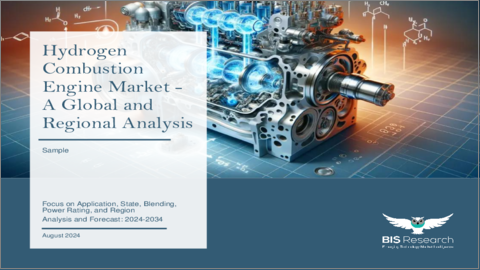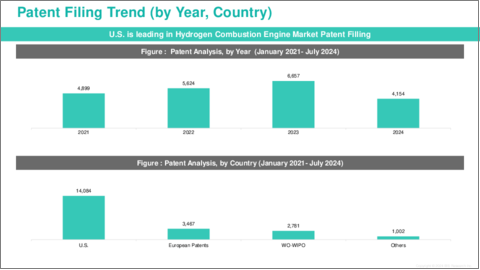|
|
市場調査レポート
商品コード
1545609
水素燃焼エンジン市場 - 世界および地域別分析:用途・状態・混合・出力定格・地域別の分析・予測 (2024~2034年)Hydrogen Combustion Engine Market - A Global and Regional Analysis: Focus on Application, State, Blending, Power Rating, and Region - Analysis and Forecast, 2024-2034 |
||||||
カスタマイズ可能
|
|||||||
| 水素燃焼エンジン市場 - 世界および地域別分析:用途・状態・混合・出力定格・地域別の分析・予測 (2024~2034年) |
|
出版日: 2024年09月02日
発行: BIS Research
ページ情報: 英文 120 Pages
納期: 1~5営業日
|
- 全表示
- 概要
- 目次
水素燃焼エンジン市場は、クリーンエネルギーソリューションへの焦点と温室効果ガス排出削減の必要性の高まりにより、エネルギー・輸送分野で急成長している分野です。
水素燃焼エンジンは、従来の化石燃料に代わるクリーンな燃料源として、気体または液体の水素を使用します。この技術は、産業界が厳しい排出規制を遵守し、環境の持続可能性を向上させようとしているため、輸送や発電をはじめとするさまざまな用途で普及しつつあります。楽観的シナリオでは、2024年の市場規模は1,320万米ドルと評価され、CAGR 35.01%で拡大し、2034年には2億6,560万米ドルに達すると予測されています。
輸送分野では、水素燃焼エンジンは乗用車、商用トラック、バスなど多様な車両に組み込まれています。この水素自動車へのシフトは、排出ガス削減の規制要件を満たす必要性と、ガソリンエンジンやディーゼルエンジンに代わる、よりクリーンで効率的な選択肢を提供することが動機となっています。同様に、発電においても、水素燃焼エンジンは、バックアップ電源システムおよび一次発電の両方に利用されており、化石燃料に依存する従来の発電機に比べてよりクリーンな選択肢を提供しています。
| 主要市場統計 | |
|---|---|
| 予測期間 | 2024-2034年 |
| 2024年評価 | 1,320万米ドル |
| 2034年予測 | 2億6,560万米ドル |
| CAGR | 35.01% |
地域別では、アジア太平洋地域が水素燃焼エンジンの最大の地域市場であり、特に中国、日本、韓国などの国々での水素インフラへの多額の投資、積極的な国家政策、技術の進歩が成長を牽引しています。北米も、特に米国とカナダにおける多額の投資と支援的な規制枠組みにより、顕著な成長を遂げています。欧州は、強力な環境政策と多額の研究資金に支えられ、水素技術導入のリーダーであり続けています。世界のその他の地域には、水素技術が徐々に普及しつつある新興市場が含まれ、世界市場の成長に寄与しています。全体として、水素燃焼エンジン市場は、技術の進歩、投資の増加、持続可能なエネルギーソリューションへの世界的シフトに支えられ、大幅な拡大が見込まれています。
当レポートでは、世界の水素燃焼エンジンの市場を調査し、業界の動向、技術・特許の動向、法規制環境、市場成長促進要因・抑制要因、市場規模の推移・予測、各種区分・地域/主要国別の詳細分析、競合情勢、主要企業のプロファイルなどをまとめています。
目次
エグゼクティブサマリー
第1章 市場:業界の展望
- 動向:現在および将来の影響評価
- サプライチェーンの概要
- R&Dレビュー
- 規制状況
- ステークホルダー分析
- 主要な世界的イベントの影響分析
- 市場力学の概要
- 市場促進要因
- 市場抑制要因
- 市場機会
第2章 水素燃焼エンジン市場:用途別
- 用途の分類
- 用途の概要
- 水素燃焼エンジン市場:用途別
- 交通機関
- 発電
第3章 水素燃焼エンジン市場:製品別
- 製品の分類
- 製品概要
- 水素燃焼エンジン市場:状態別
- ガス
- 液体
- 水素燃焼エンジン市場:混合別
- 純粋水素
- ミックスブレンド
- 水素燃焼エンジン市場:出力定格別
- 高
- 中
- 低
第4章 水素燃焼エンジン市場:地域別
- 水素燃焼エンジン市場:地域別
- 北米
- 欧州
- アジア太平洋
- その他の地域
第5章 企業プロファイル
- 次なるフロンティア
- 地理的評価
- 企業プロファイル
- Wartsila
- GARRETT MOTION INC.
- BeHydro
- DEUTZ AG
- MAN Energy Solutions SE
- Cummins Inc
- Rolls-Royce plc
- MITSUBISHI HEAVY INDUSTRIES, LTD.
- Toyota
- Kawasaki Heavy Industries, Ltd.
- Mazda Motor Corporation
- Reliance Industries Limited
- Liebherr Group
- Robert Bosch GmbH
- YANMAR HOLDINGS CO., LTD.
- その他の主要企業
第6章 調査手法
Introduction to Hydrogen Combustion Engine Market
The hydrogen combustion engine market represents a burgeoning segment within the energy and transportation sectors, driven by a growing emphasis on clean energy solutions and the need to reduce greenhouse gas emissions. Hydrogen combustion engines use hydrogen, either in its gaseous or liquid state, as a fuel source, offering a cleaner alternative to traditional fossil fuels. This technology is gaining traction in multiple applications, notably transportation and power generation, as industries seek to comply with stringent emissions regulations and improve environmental sustainability. In an optimistic scenario, the market is evaluated at a valuation of $13.2 million in 2024 and is projected to expand at a CAGR of 35.01% to reach $265.6 million by 2034.
In the transportation sector, hydrogen combustion engines are being integrated into a diverse range of vehicles, including passenger cars, commercial trucks, and buses. This shift toward hydrogen-powered vehicles is motivated by the need to meet regulatory requirements for reduced emissions and to offer cleaner, more efficient alternatives to gasoline and diesel engines. Similarly, in power generation, hydrogen combustion engines are utilized for both backup power systems and primary electricity generation, providing a cleaner option compared to conventional generators that rely on fossil fuels.
| KEY MARKET STATISTICS | |
|---|---|
| Forecast Period | 2024 - 2034 |
| 2024 Evaluation | $13.2 Million |
| 2034 Forecast | $265.6 Million |
| CAGR | 35.01% |
The market is also segmented based on the state of hydrogen used in combustion engines. Hydrogen can be in a gaseous or liquid form, each offering distinct advantages for different applications. Liquid hydrogen, with its higher energy density, is particularly suited for applications requiring substantial fuel storage, while gaseous hydrogen is commonly used where refueling infrastructure is already established. Additionally, the market is segmented by blending types, including pure hydrogen, hydrogen-gasoline blends, hydrogen-diesel blends, and hydrogen-biofuel blends. These blends are designed to optimize performance and reduce emissions based on specific operational needs.
Further segmentation by power rating divides engines into high, medium, and low power outputs, catering to various application requirements from heavy-duty industrial engines to light-duty vehicles. This classification helps address the diverse needs of the market and ensures that hydrogen combustion engines can meet a wide range of performance specifications.
Regionally, the Asia-Pacific (APAC) region is the largest market for hydrogen combustion engines, driven by significant investments in hydrogen infrastructure, ambitious national policies, and advancements in technology, particularly in countries such as China, Japan, and South Korea. North America is experiencing notable growth due to substantial investments and supportive regulatory frameworks, especially in the U.S. and Canada. Europe remains a leader in the adoption of hydrogen technologies, supported by strong environmental policies and substantial research funding. The Rest-of-the-World segment includes emerging markets where hydrogen technology is gradually gaining traction, contributing to global market growth. Overall, the hydrogen combustion engine market is poised for substantial expansion, supported by technological advancements, increasing investment, and a global shift toward sustainable energy solutions.
Market Segmentation:
Segmentation 1: by Application
- Transportation
- Power Generation
Segmentation 2: by State
- Gas
- Liquid
Segmentation 3: by Blending
- Pure Hydrogen
- Mix Blends
- Hydrogen-Gasoline
- Hydrogen-Diesel
- Hydrogen-Biofuel
- Others
Segmentation 4: by Power Rating
- High
- Medium
- Low
Segmentation 5: by Region
- North America
- Europe
- Asia-Pacific
- Rest-of-the-World
How can this report add value to an organization?
Product/Innovation Strategy: The global hydrogen combustion engine market has been extensively segmented based on various categories, such as application, state, blending, and power rating. This can help readers get a clear overview of which segments account for the largest share and which ones are well-positioned to grow in the coming years.
Competitive Strategy: A detailed competitive benchmarking of the players operating in the global hydrogen combustion engine market has been done to help the reader understand how players stack against each other, presenting a clear market landscape. Additionally, comprehensive competitive strategies such as partnerships, agreements, and collaborations will aid the reader in understanding the untapped revenue pockets in the market.
Key Market Players and Competition Synopsis
The companies that are profiled have been selected based on inputs gathered from primary experts and analysing company coverage, product portfolio, and market penetration.
Some of the prominent companies in this market are:
- Wartsila
- GARRETT MOTION INC.
- BeHydro
- DEUTZ AG
- MAN Energy Solutions SE
- Cummins Inc.
- Rolls-Royce plc
- MITSUBISHI HEAVY INDUSTRIES, LTD.
- Kawasaki Heavy Industries, Ltd.
- Mazda Motor Corporation
- Robert Bosch GmbH
- YANMAR HOLDINGS CO., LTD.
Key Questions Answered in this Report:
- What are the main factors driving the demand for hydrogen combustion engine market?
- What are the major patents filed by the companies active in the hydrogen combustion engine market?
- Who are the key players in the hydrogen combustion engine market, and what are their respective market shares?
- What partnerships or collaborations are prominent among stakeholders in the hydrogen combustion engine market?
- What are the strategies adopted by the key companies to gain a competitive edge in hydrogen combustion engine market?
- What is the futuristic outlook for the hydrogen combustion engine market in terms of growth potential?
- What is the current estimation of the hydrogen combustion engine market and what growth trajectory is projected from 2024 to 2034?
- Which application, and product segment is expected to lead the market over the forecast period (2024-2034)?
- Which regions demonstrate the highest adoption rates for hydrogen combustion engine market, and what factors contribute to their leadership?
Table of Contents
Executive Summary
Scope and Definition
Market/Product Definition
Key Questions Answered
Analysis and Forecast Note
1. Markets: Industry Outlook
- 1.1 Trends: Current and Future Impact Assessment
- 1.2 Supply Chain Overview
- 1.2.1 Value Chain Analysis
- 1.2.2 Pricing Forecast
- 1.3 R&D Review
- 1.3.1 Patent Filing Trend by Country, by Company
- 1.4 Regulatory Landscape
- 1.5 Stakeholder Analysis
- 1.5.1 Use Case
- 1.5.2 End User and Buying Criteria
- 1.6 Impact Analysis for Key Global Events
- 1.7 Market Dynamics Overview
- 1.7.1 Market Drivers
- 1.7.2 Market Restraints
- 1.7.3 Market Opportunities
2. Hydrogen Combustion Engine Market (by Application)
- 2.1 Application Segmentation
- 2.2 Application Summary
- 2.3 Hydrogen Combustion Engine Market (by Application)
- 2.3.1 Transportation
- 2.3.2 Power Generation
3. Hydrogen Combustion Engine Market (by Product)
- 3.1 Product Segmentation
- 3.2 Product Summary
- 3.3 Hydrogen Combustion Engine Market (by State)
- 3.3.1 Gas
- 3.3.2 Liquid
- 3.4 Hydrogen Combustion Engine Market (by Blending)
- 3.4.1 Pure Hydrogen
- 3.4.2 Mix Blends
- 3.4.2.1 Hydrogen-Gasoline
- 3.4.2.2 Hydrogen-Diesel
- 3.4.2.3 Hydrogen-Biofuel
- 3.4.2.4 Others
- 3.5 Hydrogen Combustion Engine Market (by Power Rating)
- 3.5.1 High
- 3.5.2 Medium
- 3.5.3 Low
4. Hydrogen Combustion Engine Market (by Region)
- 4.1 Hydrogen Combustion Engine Market (by Region)
- 4.2 North America
- 4.2.1 Regional Overview
- 4.2.2 Driving Factors for Market Growth
- 4.2.3 Factors Challenging the Market
- 4.2.4 Application
- 4.2.5 Product
- 4.2.5.1 U.S.
- 4.2.5.1.1 Market by Application
- 4.2.5.1.2 Market by Product
- 4.2.5.2 Canada
- 4.2.5.2.1 Market by Application
- 4.2.5.2.2 Market by Product
- 4.2.5.3 Mexico
- 4.2.5.3.1 Market by Application
- 4.2.5.3.2 Market by Product
- 4.2.5.1 U.S.
- 4.3 Europe
- 4.3.1 Regional Overview
- 4.3.2 Driving Factors for Market Growth
- 4.3.3 Factors Challenging the Market
- 4.3.4 Application
- 4.3.5 Product
- 4.3.5.1 Germany
- 4.3.5.1.1 Market by Application
- 4.3.5.1.2 Market by Product
- 4.3.5.2 France
- 4.3.5.2.1 Market by Application
- 4.3.5.2.2 Market by Product
- 4.3.5.3 U.K.
- 4.3.5.3.1 Market by Application
- 4.3.5.3.2 Market by Product
- 4.3.5.4 Italy
- 4.3.5.4.1 Market by Application
- 4.3.5.4.2 Market by Product
- 4.3.5.5 Rest-of-Europe
- 4.3.5.5.1 Market by Application
- 4.3.5.5.2 Market by Product
- 4.3.5.1 Germany
- 4.4 Asia-Pacific
- 4.4.1 Regional Overview
- 4.4.2 Driving Factors for Market Growth
- 4.4.3 Factors Challenging the Market
- 4.4.4 Application
- 4.4.5 Product
- 4.4.5.1 China
- 4.4.5.1.1 Market by Application
- 4.4.5.1.2 Market by Product
- 4.4.5.2 Japan
- 4.4.5.2.1 Market by Application
- 4.4.5.2.2 Market by Product
- 4.4.5.3 India
- 4.4.5.3.1 Market by Application
- 4.4.5.3.2 Market by Product
- 4.4.5.4 South Korea
- 4.4.5.4.1 Market by Application
- 4.4.5.4.2 Market by Product
- 4.4.5.5 Rest-of-Asia-Pacific
- 4.4.5.5.1 Market by Application
- 4.4.5.5.2 Market by Product
- 4.4.5.1 China
- 4.5 Rest-of-the-World
- 4.5.1 Regional Overview
- 4.5.2 Driving Factors for Market Growth
- 4.5.3 Factors Challenging the Market
- 4.5.4 Application
- 4.5.5 Product
- 4.5.5.1 South America
- 4.5.5.1.1 Market by Application
- 4.5.5.1.2 Market by Product
- 4.5.5.2 Middle East and Africa
- 4.5.5.2.1 Market by Application
- 4.5.5.2.2 Market by Product
- 4.5.5.1 South America
5. Companies Profiled
- 5.1 Next Frontiers
- 5.2 Geographic Assessment
- 5.3 Company Profiles
- 5.3.1 Wartsila
- 5.3.1.1 Overview
- 5.3.1.2 Top Products/Product Portfolio
- 5.3.1.3 Top Competitors
- 5.3.1.4 Target Customers
- 5.3.1.5 Key Personnel
- 5.3.1.6 Analyst View
- 5.3.1.7 Market Share
- 5.3.2 GARRETT MOTION INC.
- 5.3.2.1 Overview
- 5.3.2.2 Top Products/Product Portfolio
- 5.3.2.3 Top Competitors
- 5.3.2.4 Target Customers
- 5.3.2.5 Key Personnel
- 5.3.2.6 Analyst View
- 5.3.2.7 Market Share
- 5.3.3 BeHydro
- 5.3.3.1 Overview
- 5.3.3.2 Top Products/Product Portfolio
- 5.3.3.3 Top Competitors
- 5.3.3.4 Target Customers
- 5.3.3.5 Key Personnel
- 5.3.3.6 Analyst View
- 5.3.3.7 Market Share
- 5.3.4 DEUTZ AG
- 5.3.4.1 Overview
- 5.3.4.2 Top Products/Product Portfolio
- 5.3.4.3 Top Competitors
- 5.3.4.4 Target Customers
- 5.3.4.5 Key Personnel
- 5.3.4.6 Analyst View
- 5.3.4.7 Market Share
- 5.3.5 MAN Energy Solutions SE
- 5.3.5.1 Overview
- 5.3.5.2 Top Products/Product Portfolio
- 5.3.5.3 Top Competitors
- 5.3.5.4 Target Customers
- 5.3.5.5 Key Personnel
- 5.3.5.6 Analyst View
- 5.3.5.7 Market Share
- 5.3.6 Cummins Inc
- 5.3.6.1 Overview
- 5.3.6.2 Top Products/Product Portfolio
- 5.3.6.3 Top Competitors
- 5.3.6.4 Target Customers
- 5.3.6.5 Key Personnel
- 5.3.6.6 Analyst View
- 5.3.6.7 Market Share
- 5.3.7 Rolls-Royce plc
- 5.3.7.1 Overview
- 5.3.7.2 Top Products/Product Portfolio
- 5.3.7.3 Top Competitors
- 5.3.7.4 Target Customers
- 5.3.7.5 Key Personnel
- 5.3.7.6 Analyst View
- 5.3.7.7 Market Share
- 5.3.8 MITSUBISHI HEAVY INDUSTRIES, LTD.
- 5.3.8.1 Overview
- 5.3.8.2 Top Products/Product Portfolio
- 5.3.8.3 Top Competitors
- 5.3.8.4 Target Customers
- 5.3.8.5 Key Personnel
- 5.3.8.6 Analyst View
- 5.3.8.7 Market Share
- 5.3.9 Toyota
- 5.3.9.1 Overview
- 5.3.9.2 Top Products/Product Portfolio
- 5.3.9.3 Top Competitors
- 5.3.9.4 Target Customers
- 5.3.9.5 Key Personnel
- 5.3.9.6 Analyst View
- 5.3.9.7 Market Share
- 5.3.10 Kawasaki Heavy Industries, Ltd.
- 5.3.10.1 Overview
- 5.3.10.2 Top Products/Product Portfolio
- 5.3.10.3 Top Competitors
- 5.3.10.4 Target Customers
- 5.3.10.5 Key Personnel
- 5.3.10.6 Analyst View
- 5.3.10.7 Market Share
- 5.3.11 Mazda Motor Corporation
- 5.3.11.1 Overview
- 5.3.11.2 Top Products/Product Portfolio
- 5.3.11.3 Top Competitors
- 5.3.11.4 Target Customers
- 5.3.11.5 Key Personnel
- 5.3.11.6 Analyst View
- 5.3.11.7 Market Share
- 5.3.12 Reliance Industries Limited
- 5.3.12.1 Overview
- 5.3.12.2 Top Products/Product Portfolio
- 5.3.12.3 Top Competitors
- 5.3.12.4 Target Customers
- 5.3.12.5 Key Personnel
- 5.3.12.6 Analyst View
- 5.3.12.7 Market Share
- 5.3.13 Liebherr Group
- 5.3.13.1 Overview
- 5.3.13.2 Top Products/Product Portfolio
- 5.3.13.3 Top Competitors
- 5.3.13.4 Target Customers
- 5.3.13.5 Key Personnel
- 5.3.13.6 Analyst View
- 5.3.13.7 Market Share
- 5.3.14 Robert Bosch GmbH
- 5.3.14.1 Overview
- 5.3.14.2 Top Products/Product Portfolio
- 5.3.14.3 Top Competitors
- 5.3.14.4 Target Customers
- 5.3.14.5 Key Personnel
- 5.3.14.6 Analyst View
- 5.3.14.7 Market Share
- 5.3.15 YANMAR HOLDINGS CO., LTD.
- 5.3.15.1 Overview
- 5.3.15.2 Top Products/Product Portfolio
- 5.3.15.3 Top Competitors
- 5.3.15.4 Target Customers
- 5.3.15.5 Key Personnel
- 5.3.15.6 Analyst View
- 5.3.15.7 Market Share
- 5.3.16 Other Key Players
- 5.3.1 Wartsila






